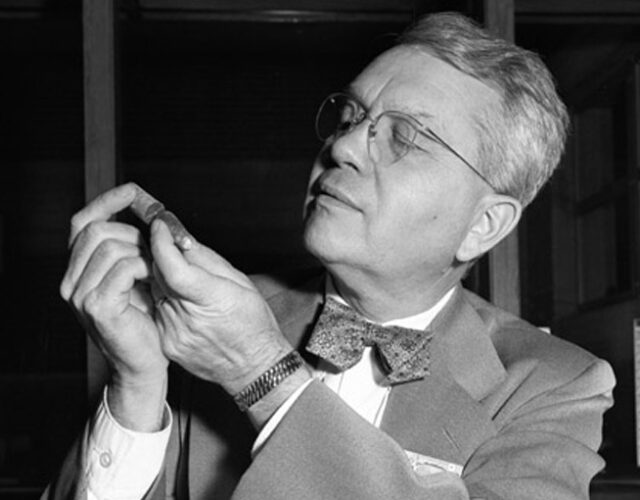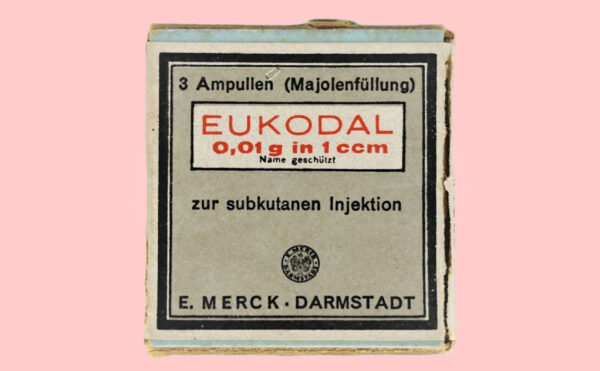The end of World War II was a time of great relief for Americans. With the economic boom that followed on its heels, it was also a time of great optimism. As the powers of Europe tended their wounds, an “American Century” appeared imminent.
Yet for many scientists—especially those who had contributed their talents and expertise to the development of America’s atomic bomb—the end of this war and the lead-up to the Cold War was also a time of great anxiety. The existence of the bomb led them to one horribly obvious conclusion: any future war could bring the end of the world as they knew it, perhaps even the annihilation of all human civilization.
Harold C. Urey, wartime director of the Manhattan Project’s uranium isotope–separation program at Columbia University, was one of the most anxious scientists in America. “I’m a frightened man,” he proclaimed in the pages of Collier’s only months after the bombings of Hiroshima and Nagasaki. “I write this to frighten you,” he added. “All the scientists I know are frightened—frightened for their lives—and frightened for your life.”
But how to survive the Atomic Age? This question preoccupied Urey for the rest of his life. His prescription for survival shifted and evolved throughout the Cold War, influenced by changes in American politics and culture. No less important in shaping Urey’s position was a very personal and occasionally uneasy balance between his religious upbringing and his scientific skepticism.
These outside forces transformed Urey’s public position on the atomic question, leading him from advocating for world governance of atomic weapons to promoting an extreme nuclear imbalance in favor of the United States and its allies. Urey also transformed his laboratory during the Cold War, introducing a new focus on the history of the earth and solar system and the origins of life.
Beginning in the 1950s Urey’s inner struggle led him to publicly call for a new synthesis of science and religion. Instead of the miraculous, he offered a grand view of the universe provided by science. Such an awe-inspiring vision, he believed, would help maintain the traditional religious morals required to prevent the use of atomic weapons.
Atomic Trauma
In the wake of Hiroshima and Nagasaki atomic scientists found themselves thrust into the public eye. Some, like theoretical physicist J. Robert Oppenheimer, head of the Manhattan Project and “father” of the atomic bomb, became official advisers to the government on atomic science. Others turned their fears to collective action, forming organizations whose missions were twofold: educate policy makers and the public about the danger of atomic weapons and promote the development of peaceful atomic research.
Urey was already a celebrity, having won the Nobel Prize in Chemistry in 1934 for the discovery of deuterium (a heavy isotope of hydrogen with a mass of 2). In their efforts to control the bomb Urey and a handful of other eminent scientists founded the Emergency Committee of Atomic Scientists. Here Urey acted as vice chairman under his fellow Nobelist and scientific hero, Albert Einstein. As one of the committee’s most public representatives Urey spent a great deal of his postwar time traveling and speaking to the public.
In the wake of the bomb this public work seemed urgent. Urey told the New Yorker in December 1945 that he had “dropped everything” related to his own research program, setting it aside until the world had received the message of fear and caution given by Urey and his colleagues. These weapons were so destructive, they argued, that the only way to keep the world safe was to institute a world government to monitor and control their further development.
In truth Urey found it difficult to even think about returning to his scientific work. “I know the bomb can destroy everything we hold valuable, and I get a sense of fear that disturbs me in my work,” he told reporters. “I feel better if I try to do something about it.”
The bomb wasn’t the only reason Urey found it difficult to return to work. He seemed anxious to distance himself physically and mentally from everything connected to his war work—work to which his earlier research in isotope separation bore too much resemblance. Urey had in fact been traumatized by his war work long before the dropping of the first bomb. The pressures of meeting the army’s timeline for the design and fabrication of a uranium isotope–separation facility, combined with clashes with military managers and his own scientific technical staff, had brought him close to a nervous breakdown.
“I know the bomb can destroy everything we hold valuable, and I get a sense of fear that disturbs me in my work,” he told reporters. “I feel better if I try to do something about it.”
While his crusade for world governance of atomic weapons initially may have afforded Urey an escape from his war trauma, this diversion soon delivered its own stresses. As Cold War tensions escalated and anti-Communist hysteria grew, any thoughts of the United States sacrificing any of its sovereignty or military strength became both unrealistic and politically risky. Those organizations and individuals who advocated for world government suffered for it.
By early 1947 Urey was all but worn down. The breakdown of negotiations between the United States and the Soviet Union over control of atomic weapons pushed Urey into a more hawkish position: the United States must maintain nuclear superiority to prevent the Soviet Union from starting a nuclear war. Meanwhile, Urey’s one-world idealism—which often went beyond the control of atomic weapons—brought attacks by the House Committee on Un-American Activities as well as an investigation by the FBI. Urey wrote to Einstein that the stress had left him exhausted but unable to sleep and that his doctors had ordered him to avoid outside activities. He even joked to the press that he was thinking of disconnecting his phone and changing his name.
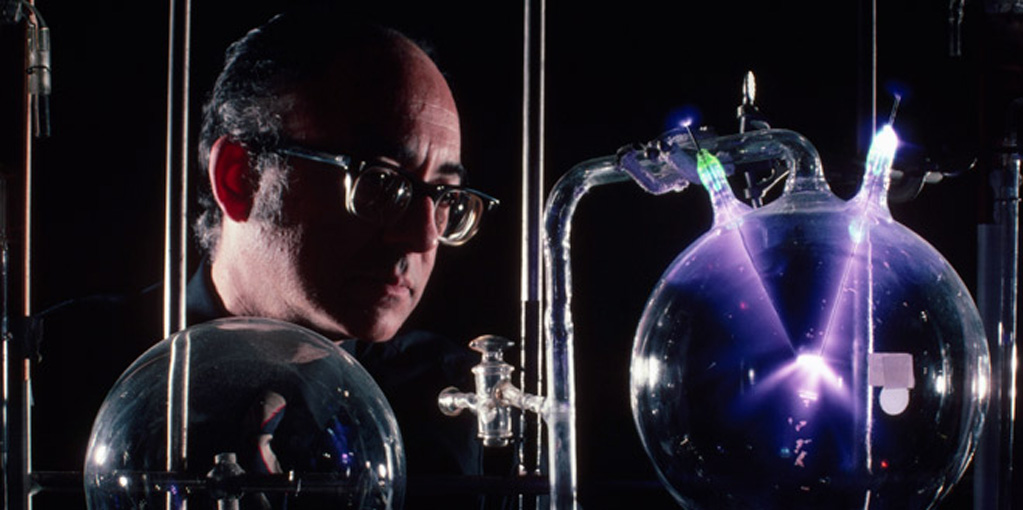
Stanley Miller demonstrates the Miller-Urey experiment, which simulated the chemical conditions of early Earth.
Mass Spectrometers, Isotopes, and Earth History
Rather than change his name, Urey went back to the lab and changed his research subject. His new work would help define an entirely new field of isotope geochemistry.
After the war Urey and several of his Columbia University colleagues—including Enrico Fermi and Joseph Mayer and Maria Goeppert-Mayer—had moved to the University of Chicago, where they established the Institute for Nuclear Studies (later renamed the Fermi Institute). The university’s president, Robert M. Hutchins, was committed to a large-scale postwar research program in nuclear physics and chemistry.
Because of his newfound aversion to isotope separation and a calendar filled with speaking engagements, Urey spent his first several months at the institute adrift with no active research projects to speak of. The institute turned out to be a good fit for Urey’s aimlessness since it emphasized applying atomic expertise to a wide range of problems. By the end of 1946 Urey had hit on a new and promising research direction—using isotope ratios in nature to answer questions from Earth’s deep past.
Oxygen-isotope ratios were the first to draw Urey’s attention. Sea creatures use oxygen atoms in the surrounding water to build their calcium carbonate (CaCO3) shells. Most oxygen is oxygen-16, but as water temperatures decrease, the ratio of oxygen-18 to oxygen-16 in shells increases minutely. Thus, shells formed in colder temperatures contain more oxygen-18 than those formed in warmer waters.
Oxygen isotopes trapped in shells would make possible, in Urey’s words, “a new thermometer of great durability . . . buried in the rocks for hundreds of millions of years after recording the temperature of some past geological epoch.” For the first time, fluctuations in ancient climates would be open to direct study.
Because the differences in isotope ratios being measured were so tiny, Urey needed a cutting-edge instrument. As it happened, he knew exactly what he wanted. During the war Urey had overseen the development of highly precise mass spectrometers designed to the specifications of his colleague Alfred O. Nier at the University of Minnesota. Urey estimated that Nier’s new mass spectrometers would allow researchers to determine the temperature at which seashells were formed to within 6°C.
This new research program invigorated Urey. As Samuel Epstein, one of Urey’s first postdoctoral researchers at the institute remembered, “He never walked up a set of stairs one step at a time, always two steps at a time. His enthusiasm for his research was contagious.”
Urey and Epstein took two years to get their spectrometers built and operating reliably, longer than Urey had initially expected. He had thought the army would sell him one of the instruments General Electric had built during the war for the Oak Ridge uranium isotope–separation facility; instead, Urey had to build his own instruments with schematics and key components from Nier’s laboratory. By February 1949 Urey’s lab had constructed the two mass spectrometers they would use in developing their “oxygen thermometer.”
Origin of Life in the Cold War
Urey always seemed content to allow his students and junior colleagues to take full credit for the work they did with him. They would be the ones to carry on this work once they left his lab, while he would move on to a new question. This was certainly the case for Urey’s graduate student Stanley Miller.
By the early 1950s Urey had moved from geochemistry to the chemistry of the solar system and the origins of Earth—an emerging field that came to be known as cosmochemistry. In 1951 Urey worked on a paper positing that early Earth had a highly reducing atmosphere (one with a low concentration of oxygen) consisting primarily of hydrogen, ammonia, methane, and water. Electrical discharges within this atmosphere, such as lightning, formed the first carbon compounds, establishing the prebiotic conditions within which life could emerge.
But how did life first start in such a harsh, hydrogen-rich environment? At the institute’s weekly seminar Urey speculated on an experiment that might shed light on the origin of life: mix water and methane, add electric discharges, and see what organic compounds formed. Back at his office Urey found a young graduate student, Stanley Miller, at his door. Miller asked if he could use this experiment as the subject of his dissertation.
At first Urey tried to talk Miller out of the project, worried the experiment might be a dead end. Miller persisted, and to Urey’s surprise the experiment produced results within a matter of weeks. The mixture of water, methane, ammonia, and hydrogen with which they had begun the experiment now contained organic compounds, including those typical of life: amino acids and sugars. In early 1953 Miller and Urey sent the results to Science, with Miller listed as the sole author. Urey was content to be thanked in a footnote.
Urey’s own work on the origins of Earth and the solar system, which included the publication of his book The Planets: Their Origin and Development, led to another diversion: lunar and planetary exploration. Insiders at NASA credit Urey’s theory of the Moon’s origins and significance as having been chief among the scientific motivations for the American lunar program.
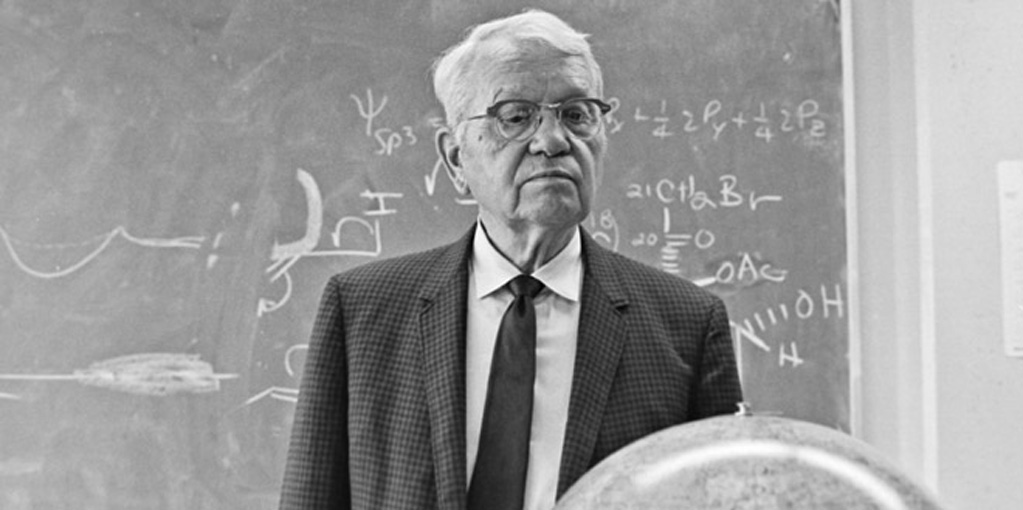
Urey studies a Moon globe, undated. Urey’s theory of the Moon’s origin was a motivating force behind the Apollo lunar program.
The “Intellectual Revolution”
Before World War II, Urey firmly believed that the world was improving with the help of science. His own field of chemistry, he told audiences in the 1930s, aimed to “abolish drudgery, discomfort, and want from the lives of men and bring them pleasure, comfort, leisure, and beauty.” A world of leisure, abundance, and peace would be the natural result if scientists were left to their work, their ideas applied to peaceful projects instead of the machines of war.
In the midst of the Cold War—through which many of his colleagues continued to work on weapons of mass destruction—Urey was no longer convinced that science possessed its own moral compass. In his “Intellectual Revolution” speech, first given in 1953, Urey presented a less optimistic view of the history of science and its effects on society. It was the story of two worlds—that of the scientist and that of the public. While the scientists produced knowledge at an increasingly rapid pace, the public only slowly absorbed and adapted to this new knowledge. For Urey the failure to adjust properly to these changes could have dire consequences, similar to those the world had witnessed in Germany and Russia.
The great discoveries and developments of the 20th century, Urey believed, deserved even greater scrutiny than those of the Scientific Revolution or the Darwinian Revolution. The latest revolution concerned the very nature of life and the universe. Copernicus had ousted humans from the center of the universe, while the discoveries of radioactivity and DNA had shown humans to be possibly just one among millions of conscious and intelligent life forms in a universe where planets like Earth might exist in great numbers. Urey worried that the public took the wrong message from science’s successes: emphasis on the practical applications of science had led many to become amoral materialists. Survival in the Atomic Age required a rigid moral compass that science alone could not provide.
The problem boiled down to religion. Urey was convinced that in order for science to work scientists themselves had to be honest and moral. Before the war Urey had believed that the practice of science shaped the morality of the scientist; nature would reveal its secrets only under the right conditions. Objectivity required self-sacrifice and sublimation. But by 1953 Urey’s ideas had changed. Scientific training could only select the objective, honest person, not create that person. The source of these ethics was the community. In the West the ethical code was that of Judaism and Christianity. Even if scientists themselves might tend toward skepticism, they had nonetheless been raised and trained in a society within which these religions still held sway.
Urey was convinced that in order for science to work scientists themselves had to be honest and moral.
It was no coincidence, Urey argued, that modern science had originated and flourished within religious societies. After all, he explained, the great religions “emphasize the greatness of men, their very great capacities to understand and assume responsibility rather than their mere animal characteristics, and the greatness of the universe, and they admonish men to think of great things and to act in great and noble ways.” The Ten Commandments, Urey claimed, dictated the terms of good research: “‘Thou shalt not lie.’ You must not lie about or misrepresent your data. ‘Thou shall not steal.’ You do not assume that you have done work which others have done.” He even went so far as to say that he did not believe “science could originate nor be maintained in a community which does not generally subscribe to and practice [these commandments].”
But as much as science seemed to depend on religion, there was little that science could do to preserve religion. Science could provide an honest and even inspiring view of the universe, but “it gives little to the ordinary non-scientific citizen which enables him to meet the spiritual needs of life.” Only religion could meet these needs. The problem was severe given the unstable nature of the Cold War world, a world faced with the possibility of nuclear war. In such a world, he argued, “It is so necessary that some inner well of strength be stirred and maintained for all men as individuals, for most occasionally, for some continuously.”
Urey presented “The Intellectual Revolution” to audiences several times during the Cold War. It ended with a plea: “The drift from that high and moral life taught to us in the past must be arrested, and we must not think that this scientific and engineering century can be built strong and true in any respect without adherence to the virtues taught in the Ten Commandments and the Sermon on the Mount. I urge all of you to try to fit the new concepts of science into the ancient teachings of religion to which we owe so much.”
The problem of retaining the traditional morals of Western religions continued to bother Urey for the rest of his career. By 1959 Urey had begun to argue that the world needed a “great prophet who can accept the facts of science and at the same time can give inspiration to fill this great void.”
Scientists could not provide a religion for the Atomic Age, but with the help of the new prophet—along with religious thinkers willing to substitute science for superstition—they could still contribute. The new religion would require the most complete and inspiring view of the universe possible, and scientists had an essential role to play.
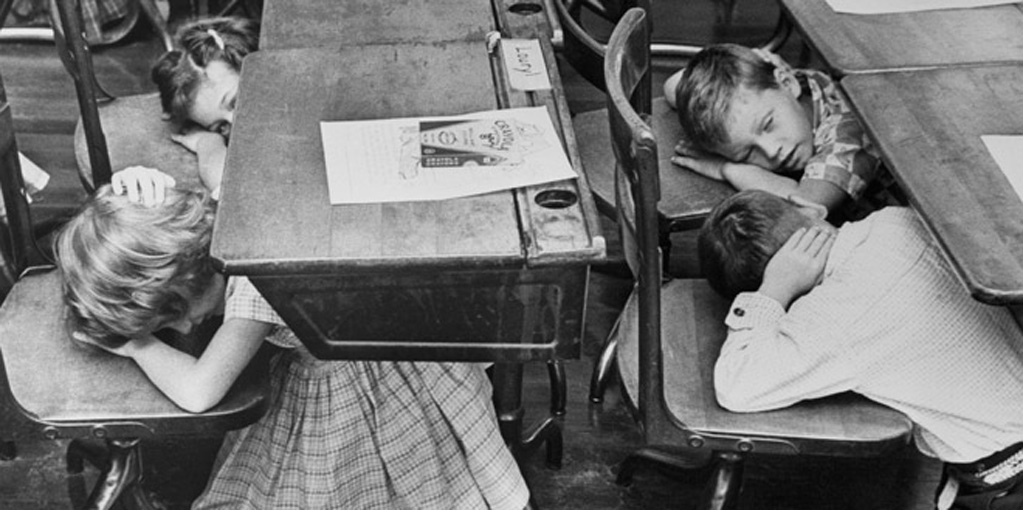
Life in the atomic age, 1962. Schoolchildren in St. Petersburg, Florida, practice a duck-and-cover disaster drill.
Religion without God
Despite Urey’s assertion of the importance of religion in his public speeches, he did not himself become more religious—at least not in the conventional sense. His life’s story was one of a movement away from religion.
The story Urey told in “The Intellectual Revolution”—of scientists raised within religious homes to be moral and honest and then bringing these morals agnostically to their research—was the story he had lived. Urey was born into a family of ministers of the Church of the Brethren, which was at the time a conservative and agrarian Christian denomination.
From high school on, Urey struggled to distance himself from his religious upbringing. On the rare occasions when he spoke about his childhood, he presented himself as the quintessential American farm boy. Rather than highlight the peculiarities of being raised in one of the original Pennsylvania Dutch religions, he instead presented himself as having emerged from “among the ordinary, common people of the United States.”
Urey did not speak or write often about his own view of God. When asked whether his scientific education had eroded or strengthened his faith in God, Urey might respond as he did to one admirer’s letter: “I myself have my own definitions of God and things of this sort, but I would not like to discuss them in public at all.” In his unpublished autobiography he admitted that he did not believe in an afterlife and believed instead that “we are all temporary, and are only part of this enormously complex universe that changes with time.” In a public forum, after reciting from memory the first chapter of Genesis, Urey said it was “beautiful poetry” but that he was more convinced by the evidence for evolution.
When Urey did invoke God, it was a God who had done little more than set the universe in motion. Urey told his pious mother and stepfather, much to their dismay, that he preferred to believe in a “God [who] opened his hand and the universe was created.” As he explained to the editor of This Christian Century, it was simply “more beautiful to have a universe that is established in such a way that it takes care of itself completely by itself than it is to assume otherwise.”
Urey told one audience that the universe was like a god: “Now this God is a God that extends in all directions from billions of light years and has existed for billions of years and will exist for billions of years in the future and maybe all these numbers should be infinite. This God has left a true record in nature which we can read while exercising some diligence.”
Ultimately, it was the universe that inspired Urey: “To me, the enormous universe and all the things in it are the source of my wonder, and I need no God to increase this wonder at all.” Urey was content to believe that the universe, beginning with the Big Bang, had proceeded to unfold and evolve without the intervention of God and that life had emerged on Earth through chance chemical events.
One Great Cloud
Urey called for a “new prophet” to create a unifying vision for science and religion, but he knew that this would not be his role. As a skeptical scientist he felt that the best he could do was investigate and contribute to the inspirational story of humankind’s place in the universe. One of his last scientific projects—conducted under the auspices of NASA’s lunar exploration program—aimed to do this on a grand scale.
In the 1950s Urey proposed that the Moon was something like a cosmochemical fossil—one whose formation dated to the very beginning of the solar system. Such an object might reveal the chemical starting point from which the Sun and planets evolved. Urey’s ideas influenced NASA’s emerging lunar-science program. As the Space Age began, Urey eagerly participated in NASA’s robotic and manned exploration of the Moon. He even analyzed lunar rocks returned by the Apollo astronauts.
In the 1950s Urey proposed that the Moon was something like a cosmochemical fossil—one whose formation dated to the very beginning of the solar system.
As a group of lunar scientists told the Washington Post during the Apollo program, “Uncle Harold is the real modern father of lunar science.” But the Moon turned out to be not what Urey expected, and no consensus over its origin emerged during his life. The Moon would be of little use to him in building the detailed chemical history of the solar system he had hoped to construct.
NASA’s lunar missions ended in 1972. Soon after, Urey’s eyesight failed, which, along with declining health that included the onset of Parkinson’s disease, robbed him of his ability to work. In 1977 he wrote to his old friend, physicist Raymond T. Birge: “I am feeling my old age every day. My hands quiver, I wobble when I walk, my eyesight is bad, and I can’t remember things so that I cannot keep up with the literature, hence I can do no scientific work at all.”
Reflecting on his life in science, Urey had mixed feelings. On the one hand, science had fulfilled many of its promises: “Think of the things that have happened in this century,” he wrote to Birge. “Almost the entire development of radioactivity has happened in this century.” But at the same time, Urey was plagued by the uncertainties unleashed by the century’s great developments. He asked Birge, “Do you think people will be here a million years from now, or even a century from now? . . . I wonder if we have not lived through an exceedingly interesting time and just before a very dreadful time when problems and disaster will plague men on the earth.”
Urey died in 1981, eight years before the fall of the Berlin Wall and the end of the Cold War. In one of his final speeches, to the graduating seniors of McGill University, he said that despite his and his colleagues’ professional success and prosperity he did not feel confident that they were leaving the world better than they had found it. There had been triumphs, but “one great cloud”—the atomic threat—still hung over their heads. At the end of his own career he could only wish the younger generation luck in clearing the cloud away.

